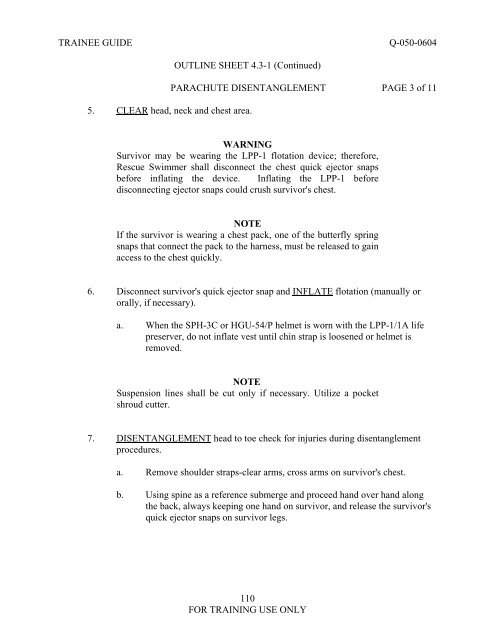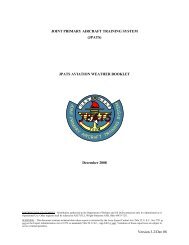Tg4-3 cng1.pdf - NETC - The US Navy
Tg4-3 cng1.pdf - NETC - The US Navy
Tg4-3 cng1.pdf - NETC - The US Navy
You also want an ePaper? Increase the reach of your titles
YUMPU automatically turns print PDFs into web optimized ePapers that Google loves.
TRAINEE GUIDE Q-050-0604<br />
OUTLINE SHEET 4.3-1 (Continued)<br />
5. CLEAR head, neck and chest area.<br />
PARACHUTE DISENTANGLEMENT PAGE 3 of 11<br />
WARNING<br />
Survivor may be wearing the LPP-1 flotation device; therefore,<br />
Rescue Swimmer shall disconnect the chest quick ejector snaps<br />
before inflating the device. Inflating the LPP-1 before<br />
disconnecting ejector snaps could crush survivor's chest.<br />
NOTE<br />
If the survivor is wearing a chest pack, one of the butterfly spring<br />
snaps that connect the pack to the harness, must be released to gain<br />
access to the chest quickly.<br />
6. Disconnect survivor's quick ejector snap and INFLATE flotation (manually or<br />
orally, if necessary).<br />
a. When the SPH-3C or HGU-54/P helmet is worn with the LPP-1/1A life<br />
preserver, do not inflate vest until chin strap is loosened or helmet is<br />
removed.<br />
NOTE<br />
Suspension lines shall be cut only if necessary. Utilize a pocket<br />
shroud cutter.<br />
7. DISENTANGLEMENT head to toe check for injuries during disentanglement<br />
procedures.<br />
a. Remove shoulder straps-clear arms, cross arms on survivor's chest.<br />
b. Using spine as a reference submerge and proceed hand over hand along<br />
the back, always keeping one hand on survivor, and release the survivor's<br />
quick ejector snaps on survivor legs.<br />
110<br />
FOR TRAINING <strong>US</strong>E ONLY









